A typical country house in this very poor country. Both walls and roof are thatched and people use hammocks for beds (one can be seen hanging in front). All houses are built on stilts because the land becomes entirely flooded during the rainy season (which had just begun). Houses, like this one, deep in the countryside have no electricity or running water. The family subsists on the rice harvested from the fields around the house.
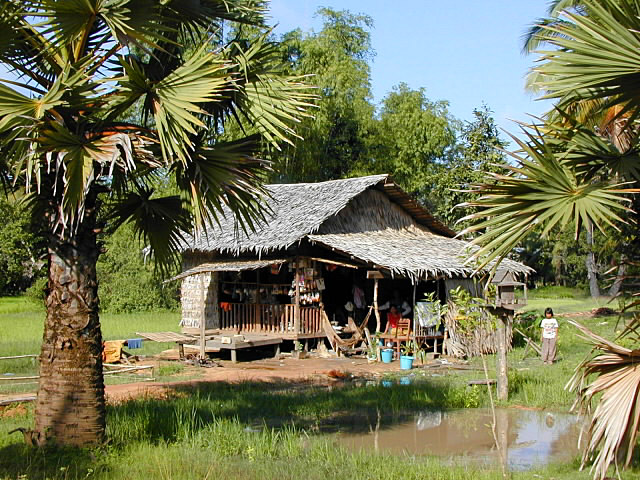
The name Angkor Wat referred originally only to a magnificent 10th century Buddhist temple (shown further down), but it is now used to signify the entire city that surrounds the temple. The city originated in the 8th century and reached its peak in the 12th century with a population estimated at several hundred thousand.
Angkor Wat defies all attempts to describe its grandeur. It is simply the most incredible archeological site that either Susan or Lee have ever seen, easily surpassing all the Roman and Greek ruins. Only the temples in the Valley of the Kings in Luxor, Egypt come close.
Incredibly, Angkor Wat was unknown to Europeans until the 19th century. The entire city had been overtaken by the jungle and looked like this when it was "discovered," with enormous vine-encrusted trees growing out of, and on top of, all the buildings. This particular area (named Ta Prohm) was left undisturbed to see it the way the European explorers did originally.
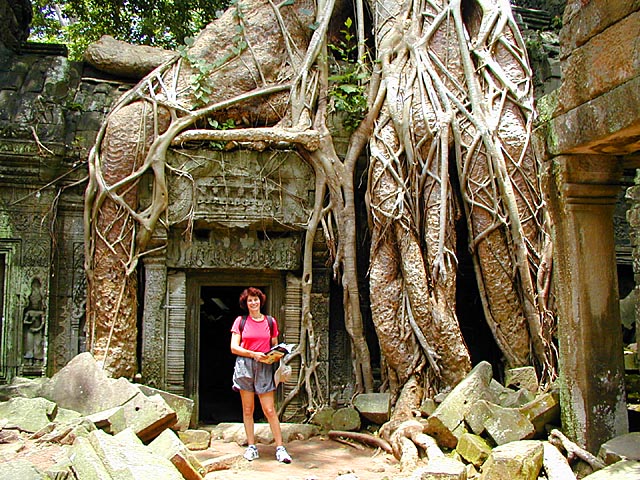
Max sits on steps of the restored Bayon Temple which is topped by a series of enormous towers, each sporting four faces of King Jayarvarman the VII looking out to the north, east, south and west, to represent that the king was omnipresent and all-powerful.

Here we are on the grounds of the grandest temple of all -- Angkor Wat. This is the largest religious edifice ever constructed. The temple is constructed in a series of square galleries, each inside of the other. The sides of the outermost gallery are half a mile long (and surrounded by a moat which used to be filled with crocodiles). The next gallery within (which can be seen behind us) has sides that are about 300 yards long. In the distance, you can see the inner towers (within two more sets of galleries), which rise to a height of 800 feet. The walls lining the galleries are covered with intricate bas relief carvings (a sample of which can be seen below).

Here is Susan standing in the window of the inner building surrounding the temple at a height of 500 feet. The jungle canopy can be seen in the distance. On the walls next to Susan are carvings of apsaras, heavenly female divinities.
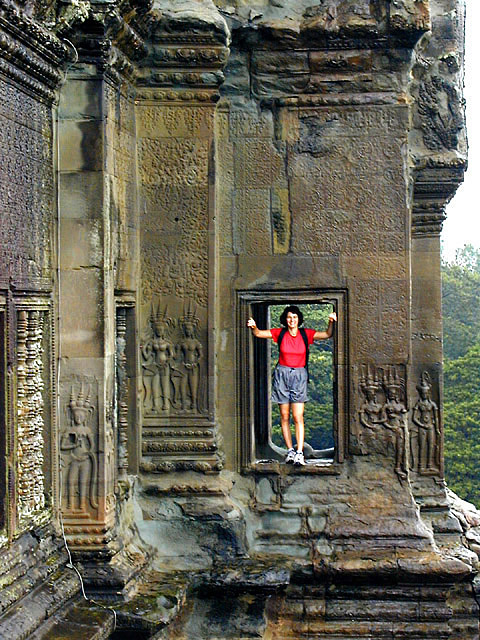
The walls of Angkor Wat have thousands of feet of carvings like this. This is a god with a thousand arms and multiple heads.

This is the facade of another temple with extremely well-preserved deep bas relief carvings. Here is the Hindu god Indra sitting on his mount, the famous three-headed elephant Airavata.

The old and the new in Angkor Wat. A motorcycle-drawn "taxi" transports a group of people past an entrance up to the "elephant terrace" which was an enormous platform used a thousand years ago for parading elephants before the royal family.

After three days touring Angkor Wat, we took a boat 150 miles down the Mekong River to the capital city of Phnom Phenh. Besides flying, there is no other way to get from one site to the other because the roads were all destroyed by the Khmer Rouge. In the distance on the left, you can see houses on the river (shown closer up in the next picture). It's hard to see at first, but we're sitting on the roof of the boat, and the wind is streaming past us since the boat is moving fast.
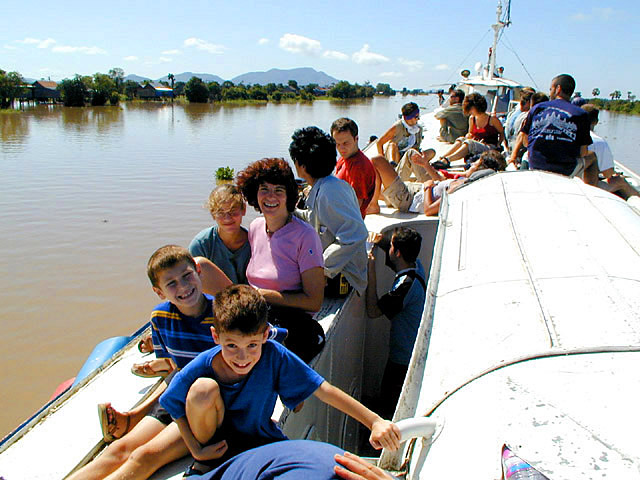
All along the river are houses on stilts or barrels. The slowly flowing brown river serves as a toilet, bath, and swimming pool for the people in these houses. They may not have running water or telephones, but the ones closer to cities have satellite dishes (see one on the left) for teenagers to watch MTV.
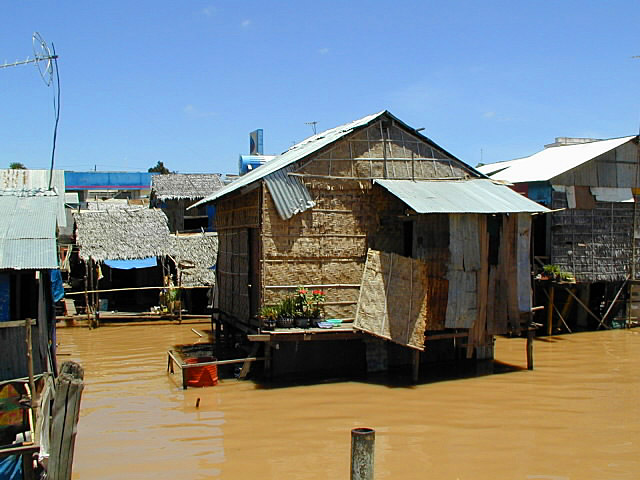
We were overwhelmed by the atrocities committed by the Khmer Rouge when they were in control of the country between 1975 and 1979. They murdered 3 million of their own people in horrific ways. Many of these murders took place on the "Killing Fields" below. The tree on the left was used to bash in the heads of babies (to avoid wasting bullets). The bodies were tossed into huge pits, some of which can be seen in the middle (with cows grazing peacefully in the distance today). After Cambodia was liberated by Vietnam in 1979, thousands of the skeletons were exhumed and put on display for all to see. The skulls were separated according to age and sex. The sign on the right says "Adult female Cambodians, aged 20 to 40."
Everyone we talked to had lost family members to the Khmer Rouge. In Phnom Phenh, our guide broke down and cried (and we did too) as she told us how she watched the murder of her entire family (father, mother, sister, and brother) when she was just 11 years old. They were marched out of Phenom Penh with the rest of the population and the city became a ghost town. Our driver in Angkor Wat, as well, was orphaned at the age of 8. We are amazed at how the Cambodian people who survived have re-built their country and re-populated their cities.

Two decades after the defeat of the Khmer Rouge, the effects of their regime have lingered on in the form of hundreds of thousands of land mines strewn across the countryside. Every year, thousands of people are killed or maimed. The mines below were discovered and deactivated before they could do their deadly work.

Everywhere, we saw people who had lost their legs by stepping on mines. The man on the left has lost both legs, the one in the middle has lost his right leg, and the one on the right has lost his left leg below the knee (he is sitting on his prothesis). These men are playing traditional Cambodian musical instruments
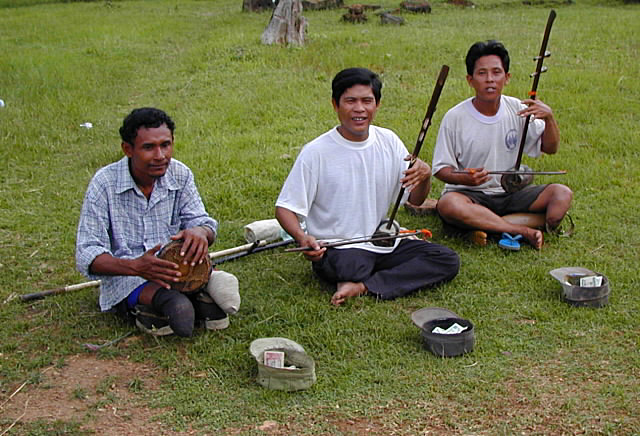
Six different kinds of poisonous snakes (including the King Cobra) crawl through the jungle. The baby python captured below is not poisonous; instead, it will kill its prey by strangulation when it grows up. We encountered it in a boat house that we stopped at during a trip on the river. Max has grabbed its head and is about to pick it up.

Click here to go to the previous page
Click here to go to the next page
Click here to go back to our main index page.